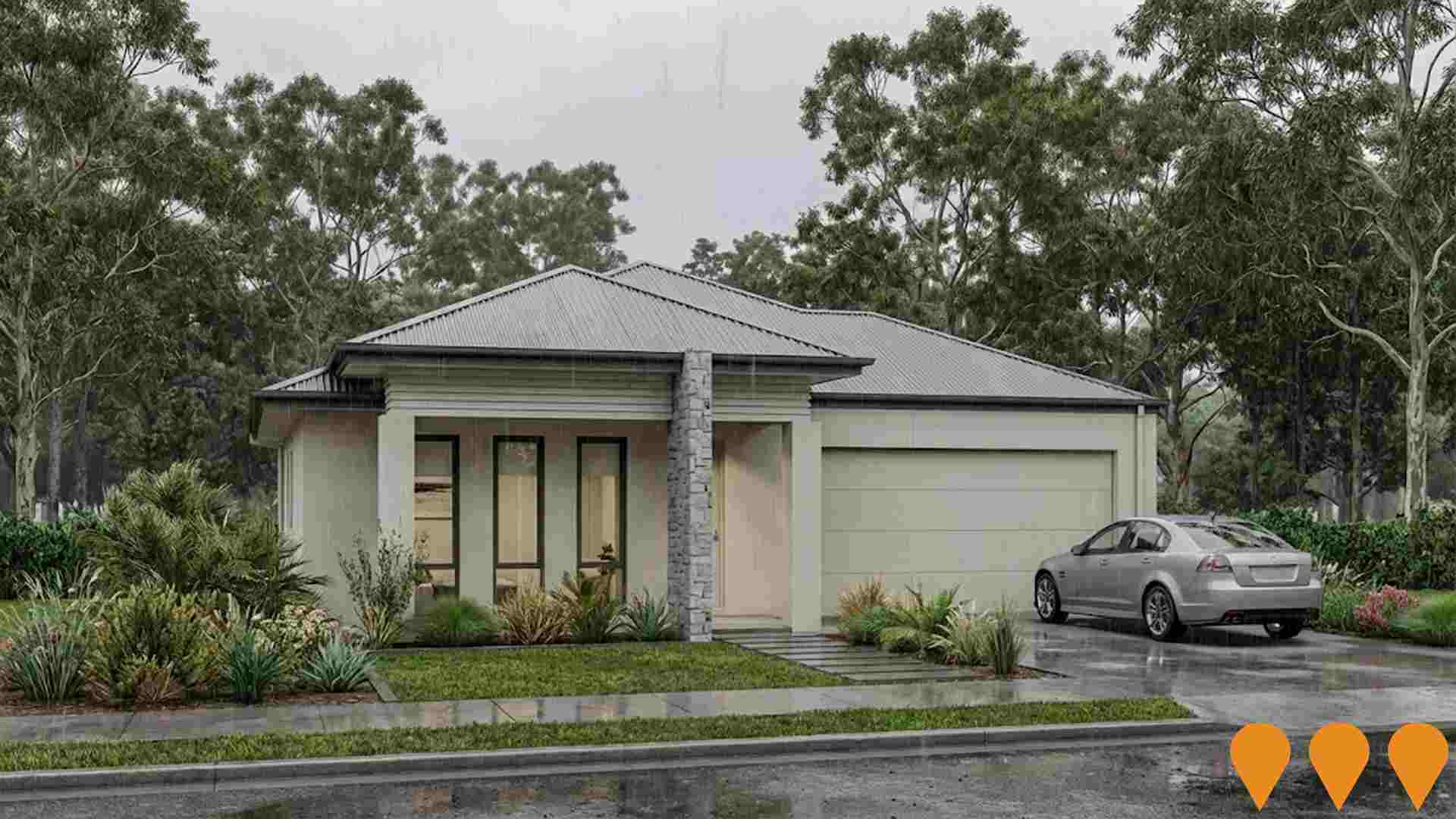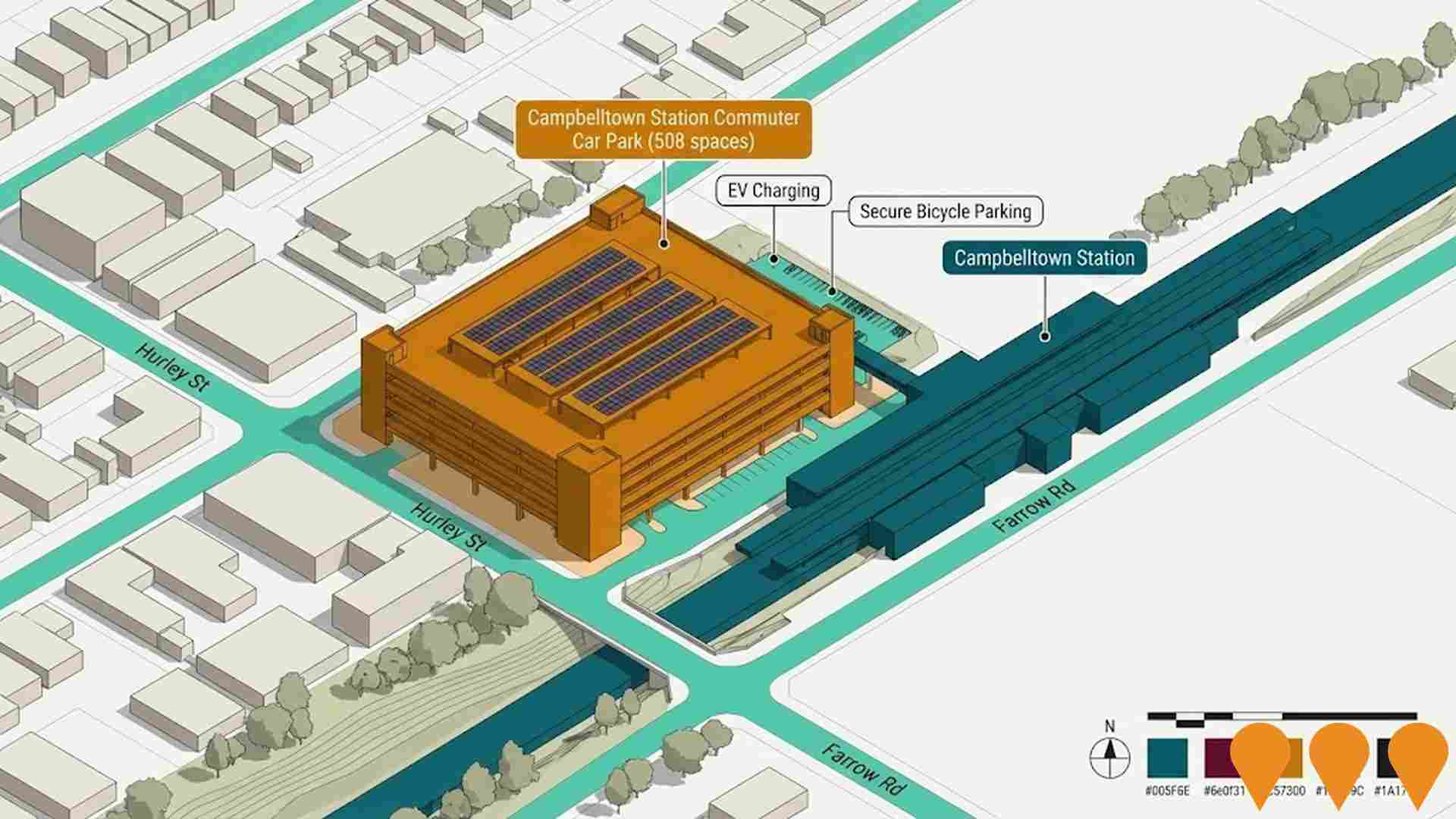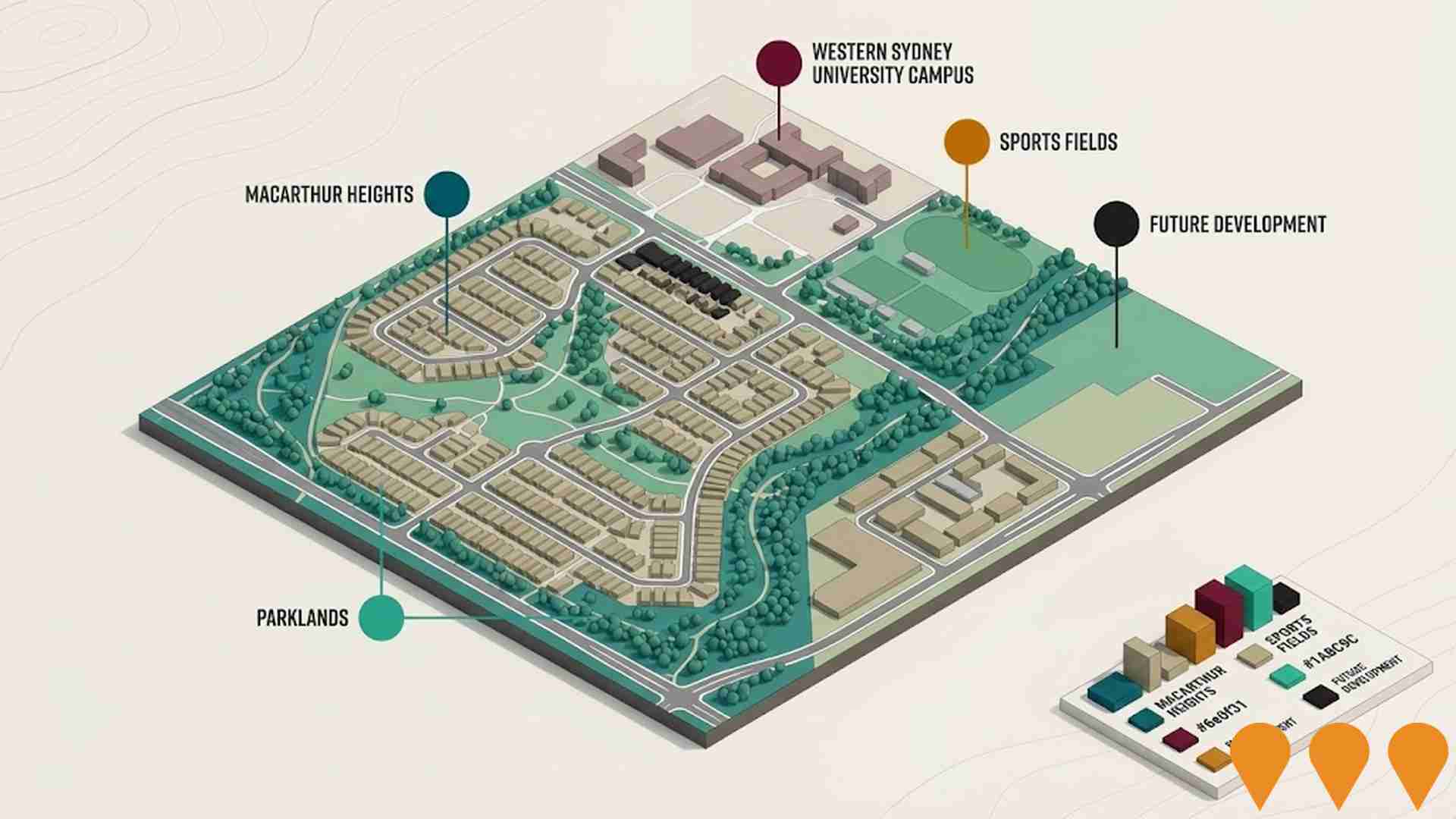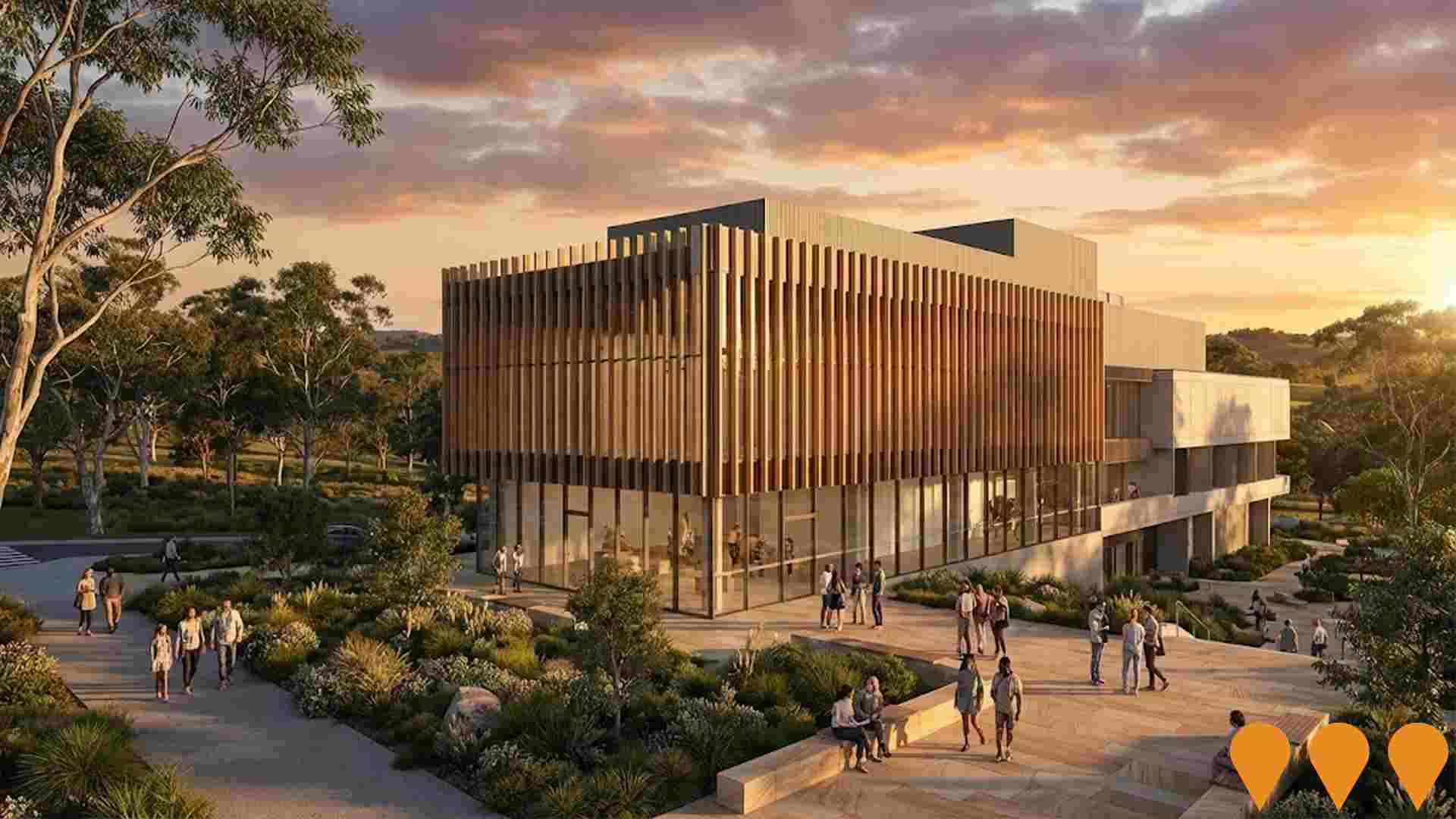Chart Color Schemes
est. as @ -- *
ABS ERP | -- people | --
2021 Census | -- people
Sales Activity
Curious about local property values? Filter the chart to assess the volume and appreciation (including resales) trends and regional comparisons, or scroll to the map below view this information at an individual property level.
Find a Recent Sale
Sales Detail
Population
Campbelltown - Woodbine lies within the top 10% of areas nationally in terms of population growth performance according to AreaSearch analysis of short and medium-term trends
Campbelltown-Woodbine's population is 24,701 as of November 2025. This figure reflects a growth of 2,617 people since the 2021 Census, which recorded a population of 22,084. The increase is inferred from ABS estimates of 24,434 in June 2024 and additional validated addresses since then. The population density is 1,796 persons per square kilometer, above national averages. Campbelltown-Woodbine's growth of 11.9% since the Census exceeded state (6.7%) and metropolitan averages. Overseas migration contributed approximately 43.1% of recent population gains.
AreaSearch uses ABS/Geoscience Australia projections for each SA2 area, released in 2024 with a base year of 2022. For areas not covered by this data, NSW State Government's SA2 level projections from 2022 using 2021 as the base year are employed. Growth rates by age group are applied to all areas for years 2032 to 2041. By 2041, Campbelltown-Woodbine is projected to grow by 9,218 persons, an increase of 36.1% over the 17-year period.
Frequently Asked Questions - Population
Development
The level of residential development activity in Campbelltown - Woodbine was found to be higher than 90% of real estate markets across the country
Campbelltown-Woodbine granted around 150 residential property approvals annually. Between FY-21 and FY-25, approximately 750 homes were approved, with an additional 29 approved in FY-26 so far. On average, 4.6 people moved to the area per dwelling built over these five years.
This indicates substantial supply lagging demand, leading to heightened buyer competition and pricing pressures. New properties are constructed at an average value of $285,000, below the regional average, suggesting more affordable housing options. In FY-26, commercial development approvals totaled $567.3 million, indicating robust local business investment. Campbelltown-Woodbine maintains similar construction rates per person compared to Greater Sydney, though building activity has slowed in recent years.
New development consists of 50% detached dwellings and 50% medium and high-density housing, providing accessible entry options for downsizers, investors, and entry-level buyers. With around 265 people per dwelling approval, Campbelltown-Woodbine shows a developing market. By 2041, the area is expected to grow by approximately 8,914 residents. If current development rates continue, housing supply may not keep pace with population growth, potentially increasing buyer competition and supporting stronger price growth.
Frequently Asked Questions - Development
Infrastructure
Campbelltown - Woodbine has very high levels of nearby infrastructure activity, ranking in the top 20% nationally
A total of 59 infrastructure projects have been identified by AreaSearch as potentially impacting the area. These include Queen Square in Campbelltown, the Campbelltown Station Commuter Car Park project, the vertical expansion of Western Sydney University's Campbelltown Campus, and Macarthur Heights. The following list details those projects likely to be most relevant.
Professional plan users can use the search below to filter and access additional projects.
INFRASTRUCTURE SEARCH
 Denotes AI-based impression for illustrative purposes only, not to be taken as definitive under any circumstances. Please follow links and conduct other investigations from the project's source for actual imagery. Developers and project owners wishing us to use original imagery please Contact Us and we will do so.
Denotes AI-based impression for illustrative purposes only, not to be taken as definitive under any circumstances. Please follow links and conduct other investigations from the project's source for actual imagery. Developers and project owners wishing us to use original imagery please Contact Us and we will do so.
Frequently Asked Questions - Infrastructure
Reimagining Campbelltown City Centre Master Plan
Council-adopted strategic master plan to transform Campbelltown city centre into the capital of the Western Parkland City. Focuses on higher-density mixed-use development, improved public domain, better connectivity and activation of Queen Street and surrounds. Exhibition of the draft Planning Proposal (LEP & DCP amendments) closed in late 2024; now under assessment by NSW Department of Planning for gateway determination.

Western Sydney University Campbelltown Campus Vertical Expansion
Major vertical expansion of WSU Campbelltown Campus including the new Lang Walker AO Medical Research Building (medical school and advanced research facilities), a 9-level Clinical Training and Simulation Tower, new student accommodation, and associated health/education precinct upgrades to support Western Sydney's growing healthcare workforce training and research.
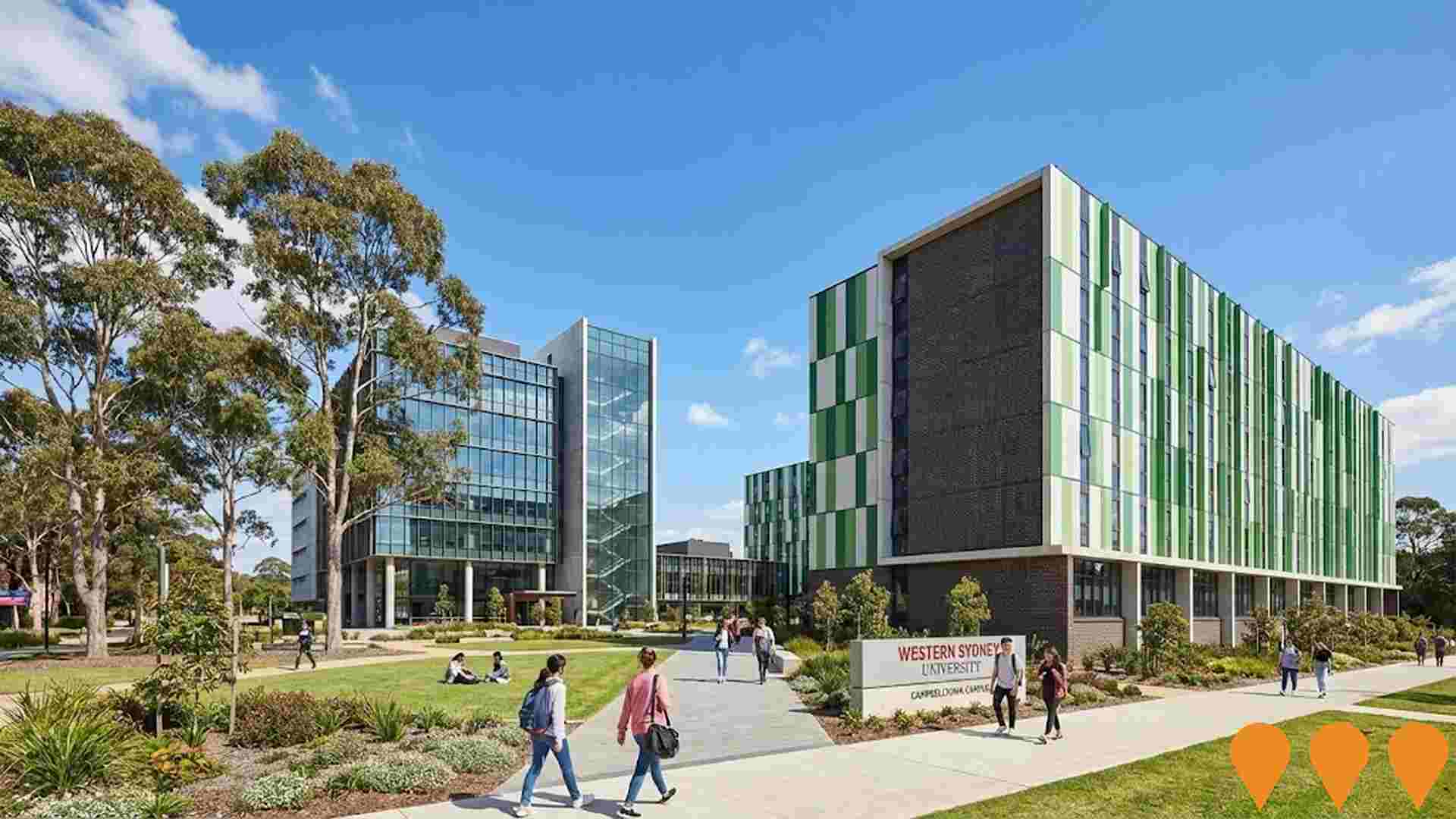
Campbelltown Hospital Redevelopment Stage 2
The $632 million Campbelltown Hospital Redevelopment Stage 2 is complete, providing a world-class healthcare facility for the Macarthur region. The project included a new 12-storey clinical services building with a new emergency department, intensive care unit, and state-of-the-art operating theatres. It also delivered expanded mental health services, new nuclear medicine and dental services, and enhanced women's health services, including birthing suites and a maternity ward. The redevelopment significantly increases the region's capacity to handle complex health cases.
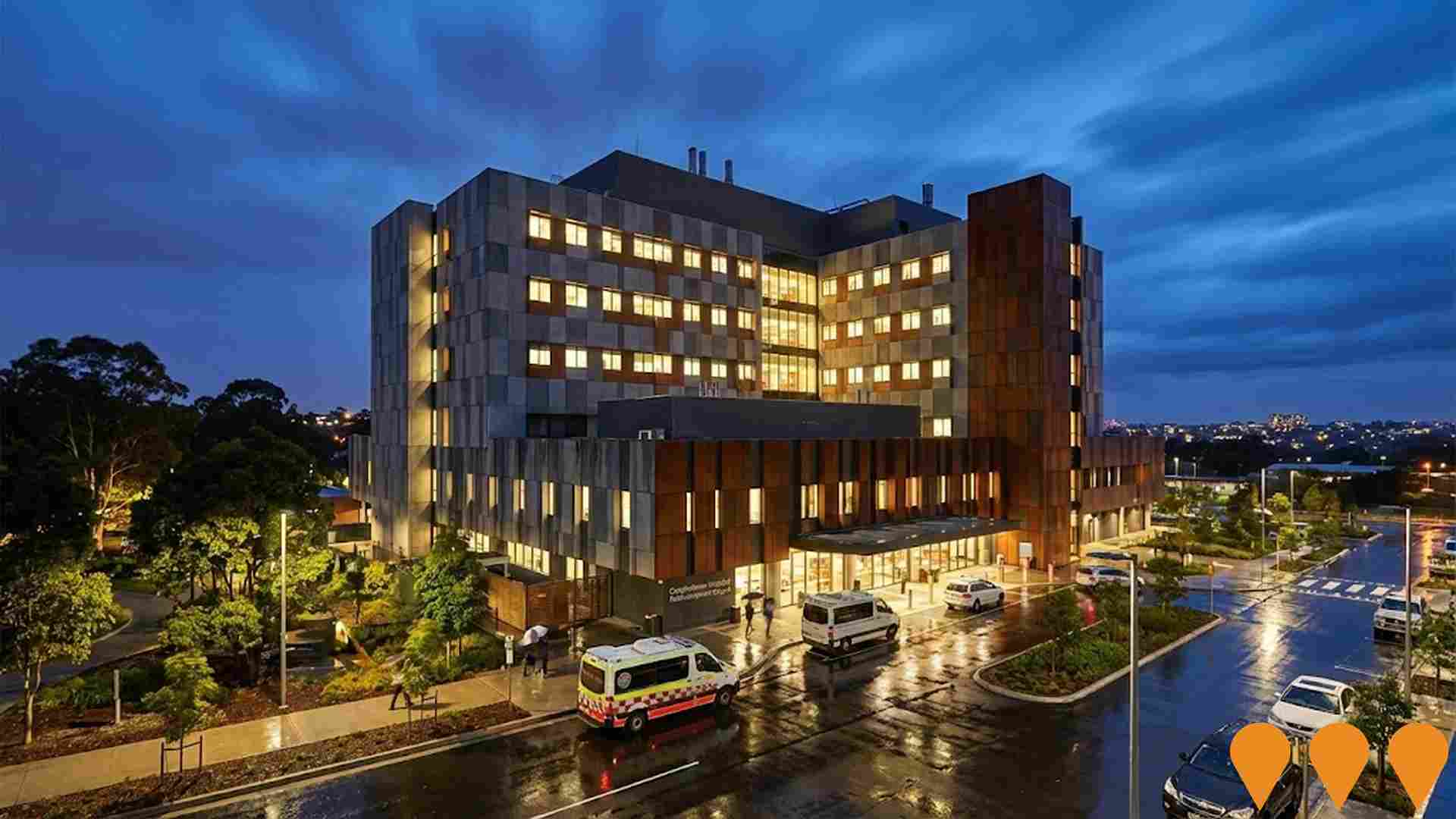
Macarthur Cancer Therapy Centre Extension
$15 million expansion featuring additional Linear Accelerator (LINAC) with targeted laser technology for precise radiotherapy treatments. Enhanced cancer care capacity for Southwest Sydney.
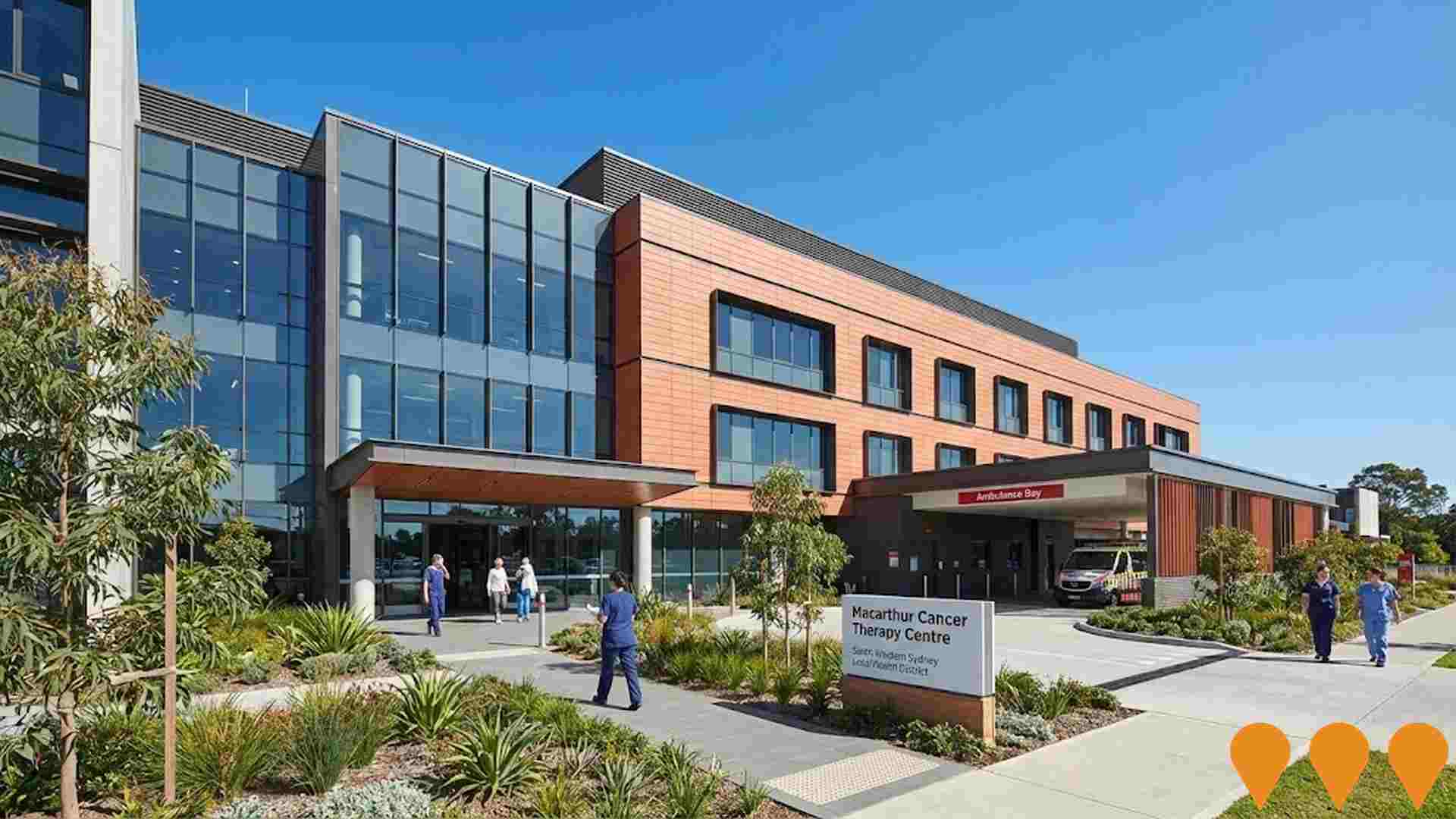
GenesisCare Campbelltown Cancer Centre
A $54 million integrated cancer centre and research hub within the Macarthur Health Precinct delivering radiation and medical oncology, haematology, clinical trials, on-site imaging and pathology. Facility includes 2 radiation bunkers, oncology chairs and specialist consult suites, targeting a 6 Star Green Star rating.

Queen Square Campbelltown
Transformational $400 million mixed-use precinct by ALAND, approved by the Regional Planning Panel. It comprises 558 residential apartments across five buildings (12-15 storeys), over 9,000sqm of retail and commercial space, including an 'Eat Street' dining precinct, and over 4,000sqm of publicly accessible open space with a two-level community building. The development is on the former Brands on Sale outlet site and aims to revitalise the Campbelltown city centre as a new urban neighbourhood and gateway. Construction is planned to commence in 2024.
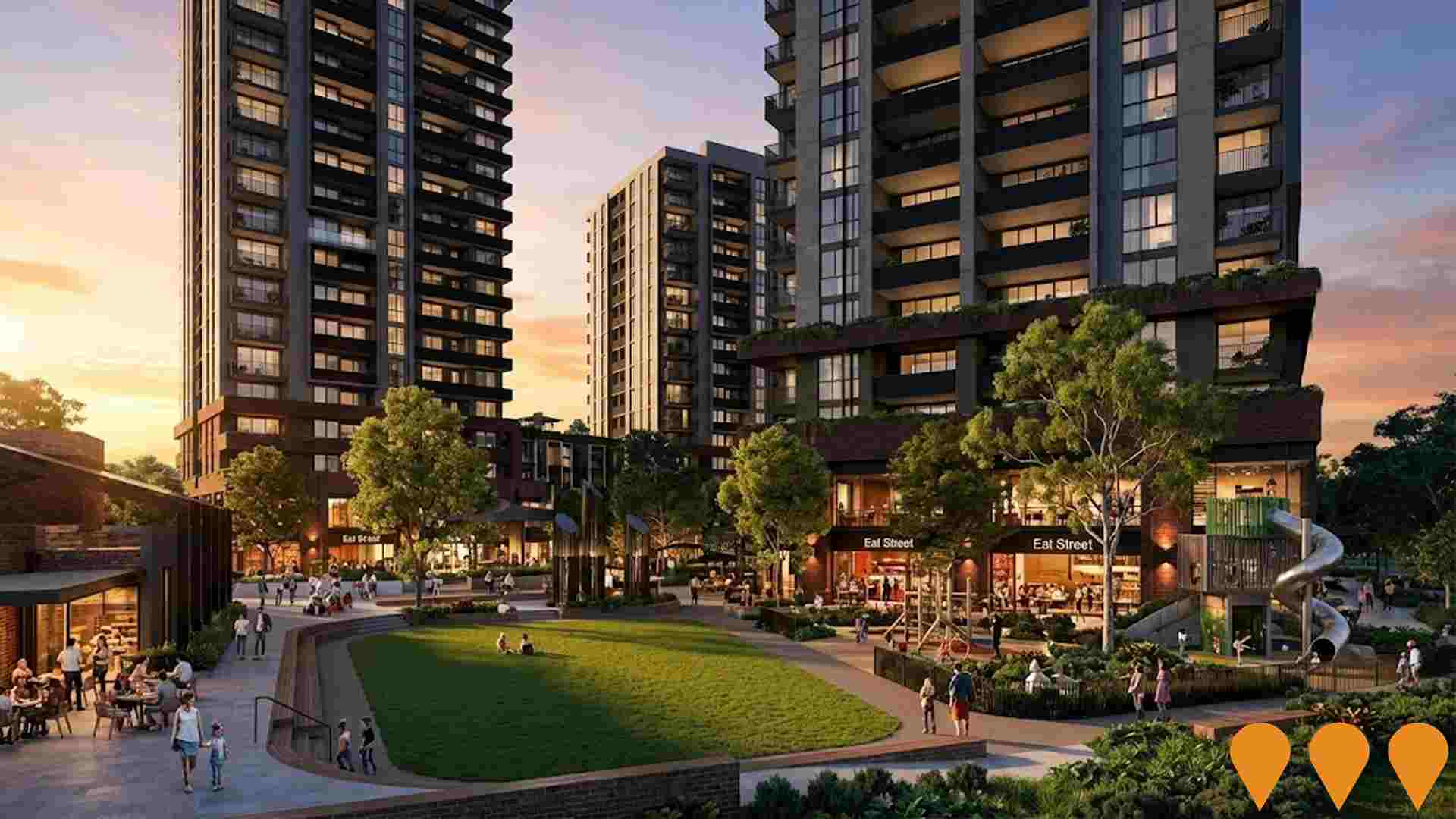
Spring Farm Riverside Estate
Spring Farm Riverside comprises 1,100 residential lots carefully planned around the Nepean River and existing 10-hectare Springs Lake. The development includes boardwalks, parks, BBQ areas, playgrounds, 185 hectares of bike paths and walkways, picnic areas by the water's edge, and blocks ranging from 390m2 to 800m2 with premium lakeside and riverside positions.
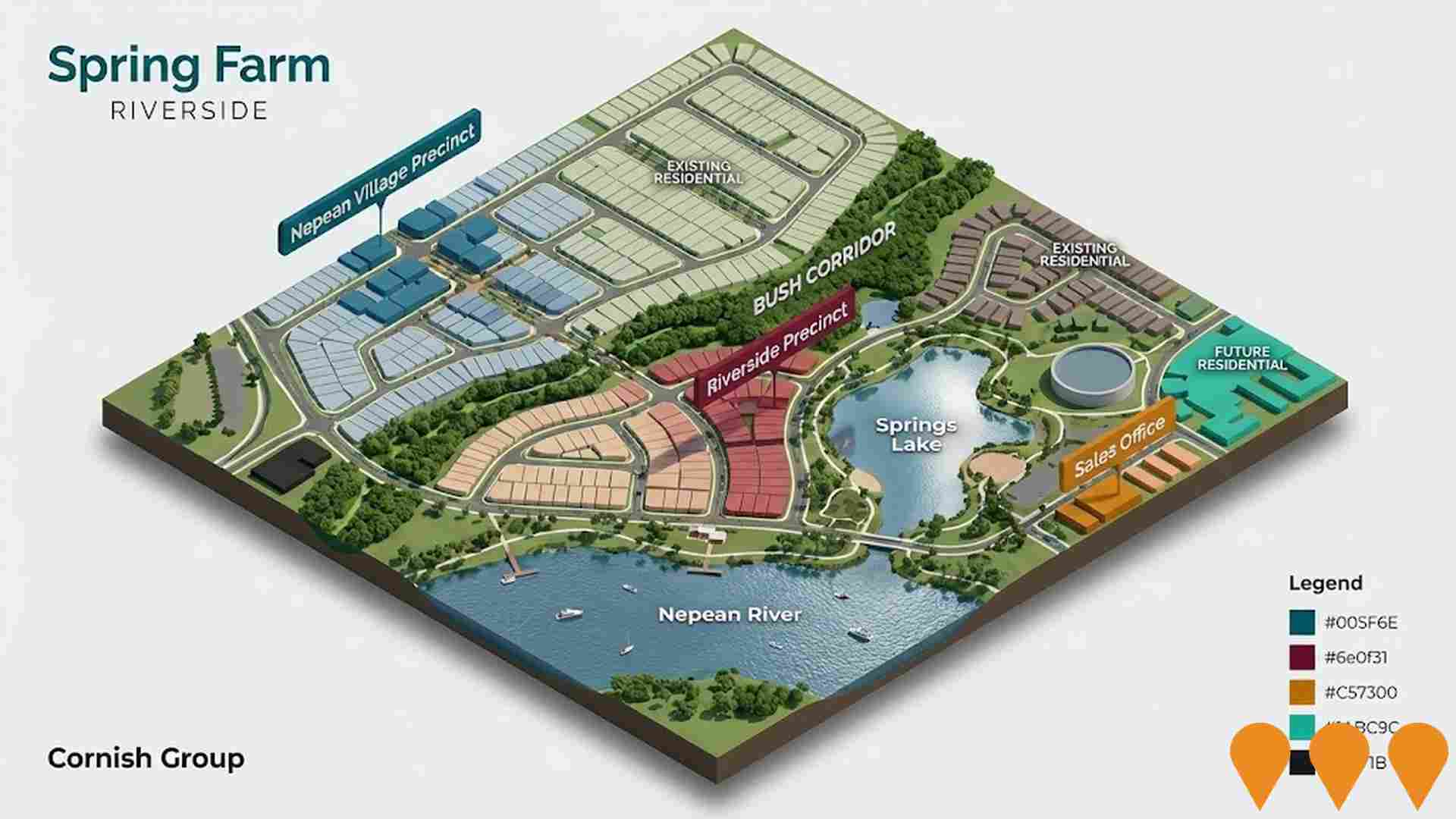
Macarthur Square Shopping Centre Redevelopment
Completed $240 million retail redevelopment of south west Sydney's premier shopping centre by Lendlease. The project included expansion of retail space, new dining precinct, upgraded amenities, improved access and connectivity, modernized facades and public spaces, creating a vibrant community hub for the Campbelltown region.

Employment
Campbelltown - Woodbine shows employment indicators that trail behind approximately 70% of regions assessed across Australia
Campbelltown-Woodbine has a skilled workforce with essential services sectors well represented. The unemployment rate was 6.9% as of June 2025, having grown by an estimated 6.2% over the past year.
As of that date, 12,308 residents were employed while the unemployment rate was 2.7% higher than Greater Sydney's rate of 4.2%. Workforce participation in Campbelltown-Woodbine stood at 56.0%, compared to Greater Sydney's 60.0%. The dominant employment sectors among residents included health care & social assistance, retail trade, and manufacturing. Notably, health care & social assistance had employment levels at 1.3 times the regional average.
Conversely, professional & technical services were under-represented, with only 5.6% of Campbelltown-Woodbine's workforce compared to Greater Sydney's 11.5%. The ratio of 0.9 workers per resident indicated substantial local employment opportunities. Over the 12 months to June 2025, employment increased by 6.2%, while labour force grew by 4.9%, causing a fall in unemployment rate by 1.1 percentage points. In comparison, Greater Sydney recorded employment growth of 2.6% and labour force growth of 2.9%, with unemployment rising by 0.3 percentage points. Jobs and Skills Australia's national employment forecasts from May 2025 projected national employment growth of 6.6% over five years and 13.7% over ten years. Applying these projections to Campbelltown-Woodbine's employment mix suggested local growth of approximately 6.5% over five years and 13.7% over ten years, though these are simple weighted extrapolations for illustrative purposes and do not account for localized population projections.
Frequently Asked Questions - Employment
Income
Income levels align closely with national averages, indicating typical economic conditions for Australian communities according to AreaSearch analysis
Campbelltown - Woodbine had median taxpayer income of $53,126 and average income of $60,973 in financial year 2022. This was below Greater Sydney's median income of $56,994 and average income of $80,856. By September 2025, estimates suggest median income would be approximately $59,825 and average income $68,662, based on Wage Price Index growth of 12.61%. In 2021 Census figures, Campbelltown - Woodbine's incomes ranked modestly, between the 38th and 38th percentiles for household, family, and personal incomes. The $1,500 - 2,999 earnings band captured 33.7% of the community (8,324 individuals), similar to regional levels at 30.9%. Housing affordability pressures were severe, with only 78.3% of income remaining, ranking at the 32nd percentile. The area's SEIFA income ranking placed it in the 4th decile.
Frequently Asked Questions - Income
Housing
Campbelltown - Woodbine displays a diverse mix of dwelling types, with a higher proportion of rental properties than the broader region
Dwelling structure in Campbelltown - Woodbine, as per the latest Census, consisted of 60.5% houses and 39.6% other dwellings (semi-detached, apartments, 'other' dwellings). In comparison, Sydney metro had 78.5% houses and 21.5% other dwellings. Home ownership in Campbelltown - Woodbine stood at 20.7%, with the remaining dwellings either mortgaged (33.2%) or rented (46.2%). The median monthly mortgage repayment was $2,023, lower than Sydney metro's $2,100. Median weekly rent in Campbelltown - Woodbine was $390, compared to Sydney metro's $380. Nationally, Campbelltown - Woodbine's mortgage repayments were higher at $2,023 versus the Australian average of $1,863, while rents were also higher at $390 compared to the national figure of $375.
Frequently Asked Questions - Housing
Household Composition
Campbelltown - Woodbine has a typical household mix, with a lower-than-average median household size
Family households account for 67.8% of all households, including 30.7% couples with children, 22.4% couples without children, and 13.3% single parent families. Non-family households constitute the remaining 32.2%, with lone person households at 28.6% and group households comprising 3.6%. The median household size is 2.6 people, which is smaller than the Greater Sydney average of 2.9.
Frequently Asked Questions - Households
Local Schools & Education
Campbelltown - Woodbine shows below-average educational performance compared to national benchmarks, though pockets of achievement exist
The area has lower university qualification rates at 25.8% compared to Greater Sydney's average of 38.0%. Bachelor degrees are the most common at 17.4%, followed by postgraduate qualifications (6.6%) and graduate diplomas (1.8%). Vocational credentials are prominent, with 33.5% of residents aged 15+ holding them, including advanced diplomas (11.0%) and certificates (22.5%). Educational participation is high at 30.7%, comprising primary education (9.9%), secondary education (7.8%), and tertiary education (6.1%).
There are 12 schools serving 3,077 students, with typical Australian school conditions (ICSEA: 989) and balanced educational opportunities. The mix includes 7 primary, 3 secondary, and 2 K-12 schools. School places per 100 residents is lower at 12.5 compared to the regional average of 17.3, with some students likely attending schools in nearby areas. Note: for schools marked 'n/a' for enrolments, refer to the parent campus.
Frequently Asked Questions - Education
Schools Detail
Nearby Services & Amenities
Transport
Transport servicing is high compared to other areas nationally based on assessment of service frequency, route connectivity and accessibility
Campbelltown-Woodbine has 199 active public transport stops. These are served by 178 routes that facilitate 16,080 weekly passenger trips. Residents' average distance to the nearest stop is 188 meters.
The service frequency is 2,297 trips per day across all routes, equating to about 80 weekly trips per individual stop.
Frequently Asked Questions - Transport
Transport Stops Detail
Health
Health outcomes in Campbelltown - Woodbine are marginally below the national average with the level of common health conditions among the general population somewhat typical, though higher than the nation's average among older cohorts
Health indicators in Campbelltown - Woodbine suggest below-average health outcomes compared to national averages. While common health conditions are somewhat typical among the general population, they are higher than average for older cohorts.
Private health cover is relatively low at approximately 50% of the total population (~12,350 people), which is lower than the national average of 55.3%. The most common medical conditions in the area are arthritis and mental health issues, impacting 8.1 and 7.8% of residents respectively. Meanwhile, 68.9% of residents declare themselves completely clear of medical ailments, compared to 70.3% across Greater Sydney. As of a recent report (2021), the area has 14.9% of residents aged 65 and over (3,673 people). Health outcomes among seniors require more attention than the broader population due to presenting some challenges.
Frequently Asked Questions - Health
Cultural Diversity
Campbelltown - Woodbine is among the most culturally diverse areas in the country based on AreaSearch assessment of a range of language and cultural background related metrics
Campbelltown-Woodbine has a significant cultural diversity, with 38.5% of its population born overseas and 37.1% speaking a language other than English at home. Christianity is the predominant religion in Campbelltown-Woodbine, comprising 53.1% of people. Islam is notably overrepresented compared to Greater Sydney, making up 11.6% of Campbelltown-Woodbine's population versus 12.5%.
The top three ancestry groups are Other (20.1%), Australian (18.8%), and English (18.8%). Some ethnic groups show notable divergences: Samoan is overrepresented at 2.6% compared to the regional average of 2.4%, Filipino at 4.7% versus 3.3%, and Lebanese at 1.7% compared to 1.9%.
Frequently Asked Questions - Diversity
Age
Campbelltown - Woodbine's population is younger than the national pattern
Campbelltown-Woodbine's median age of 35 years is slightly younger than Greater Sydney's 37 and the national average of 38 years. The 0-4 age group comprises 6.7% of its population, compared to Greater Sydney. The 55-64 age cohort makes up 9.5%. Between 2021 and present, the 35-44 age group has increased from 14.9% to 15.8%, while the 25-34 cohort has decreased from 16.8% to 16.0%. By 2041, population forecasts suggest significant demographic changes in Campbelltown-Woodbine. The 45-54 age group is projected to rise substantially, with an increase of 1,584 people (56%), from 2,813 to 4,398.

